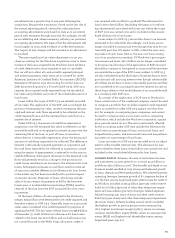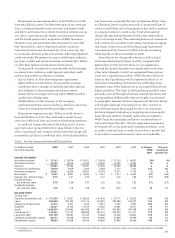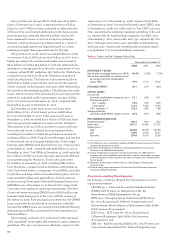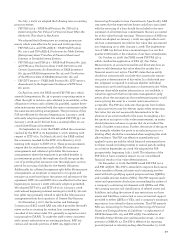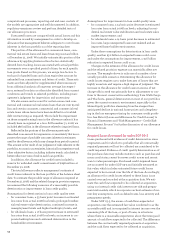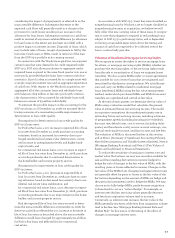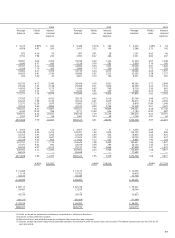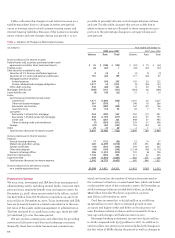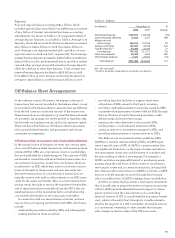Wells Fargo 2008 Annual Report Download - page 47
Download and view the complete annual report
Please find page 47 of the 2008 Wells Fargo annual report below. You can navigate through the pages in the report by either clicking on the pages listed below, or by using the keyword search tool below to find specific information within the annual report.The degree of management judgment involved in deter-
mining the fair value of a financial instrument is dependent
upon the availability of quoted market prices or observable
market parameters. For financial instruments that trade
actively and have quoted market prices or observable market
parameters, there is minimal subjectivity involved in measur-
ing fair value. When observable market prices and parame-
ters are not fully available, management judgment is neces-
sary to estimate fair value. In addition, changes in the market
conditions may reduce the availability of quoted prices or
observable data. For example, reduced liquidity in the capital
markets or changes in secondary market activities could
result in observable market inputs becoming unavailable.
When significant adjustments are required to available
observable inputs, it may be appropriate to utilize an esti-
mate based primarily on unobservable inputs. When an
active market for a security does not exist, the use of manage-
ment estimates that incorporate current market participant
expectations of future cash flows, and include appropriate
risk premiums, is acceptable.
Approximately 19% of total assets ($247.5 billion) at
December 31, 2008, and 22% of total assets ($123.8 billion) at
December 31, 2007, consisted of financial instruments record-
ed at fair value on a recurring basis. Assets for which fair val-
ues were measured using significant Level 3 inputs repre-
sented approximately 19% of these financial instruments (4%
of total assets) at December 31, 2008, and approximately 18%
(4% of total assets) at December 31, 2007. The fair value of the
remaining assets were measured using valuation methodolo-
gies involving market-based or market-derived information,
collectively Level 1 and 2 measurements.
Our financial assets valued using Level 3 measurements
consisted of certain asset-backed securities, including those
collateralized by auto leases and cash reserves, private collat-
eralized mortgage obligations (CMOs), collateralized debt
obligations (CDOs), collateralized loan obligations (CLOs),
auction-rate securities, certain derivative contracts such as
credit default swaps related to CMO, CDO and CLO expo-
sures and certain MHFS and MSRs. While MSR valuations
generally require use of significant unobservable inputs and
therefore are classified as Level 3, significant judgment may
be required to determine whether certain other assets mea-
sured at fair value are included in Level 2 or Level 3. For
example, we closely monitor market conditions involving
assets that have become less actively traded, such as MHFS,
private CMOs, and certain other debt securities, including
CDOs and CLOs. See Note 8 (Securitizations and Variable
Interest Entities) to Financial Statements for a detailed dis-
cussion of the key assumptions used to determine the fair
value of our MSRs and the related sensitivity analysis. If fair
value measurement is based upon recent observable market
activity of such assets or comparable assets (other than
forced or distressed transactions) that occur in sufficient vol-
ume and do not require significant adjustment using unob-
servable inputs, those assets are classified as Level 2; if not,
they are classified as Level 3. Making this assessment
requires significant judgment. In 2008, $4.3 billion of fair
value option MHFS and $1.9 billion of debt securities avail-
able for sale were transferred from Level 2 to Level 3 because
significant inputs to the valuation became unobservable,
largely due to reduced levels of market liquidity.
We use prices from independent pricing services and to a
lesser extent, indicative (non-binding) quotes from indepen-
dent brokers, to measure fair value of our investment securi-
ties. See Note 17 (Fair Values of Assets and Liabilities) to
Financial Statements for the amount and fair value hierarchy
classification of those securities measured at fair value using
an independent pricing service and those measured at fair
value using broker quotes. We utilize multiple independent
pricing services and brokers to obtain fair values, however,
we generally obtain one price/quote for each individual secu-
rity. For securities priced by independent pricing services, we
determine the most appropriate and relevant pricing service
for each security class and have that vendor provide the price
for each security in the class. We record the unadjusted value
provided by the independent pricing service/broker in our
financial statements, subject to our internal price verification
procedures. We validate prices received from pricing services
or brokers using a variety of methods, including, but not lim-
ited to, comparison to secondary pricing services, corrobora-
tion of pricing by reference to other independent market data
such as secondary broker quotes and relevant benchmark
indices, and review of pricing by Company personnel familiar
with market liquidity and other market-related conditions.
Based upon our internal price verification procedures and
review of fair value methodology documentation provided by
independent pricing services, we have concluded that the fair
values for our investment securities at year end were consis-
tent with the guidance in FAS 157.
Approximately 2% of total liabilities ($18.8 billion) at
December 31, 2008, and 0.5% ($2.6 billion) at December 31,
2007, consisted of financial instruments recorded at fair value
on a recurring basis. Liabilities valued using Level 3 measure-
ments were $638 million and $280 million at December 31,
2008 and 2007, respectively.
See Note 17 (Fair Values of Assets and Liabilities) to
Financial Statements for a complete discussion on our use of
fair valuation of financial instruments, our related measurement
techniques and its impact to our financial statements.
Pension Accounting
We account for our defined benefit pension plans using an
actuarial model required by FAS 87, Employers’ Accounting
for Pensions, as amended by FAS 158, Employers’ Accounting
for Defined Benefit Pension and Other Postretirement Plans –
an amendment of FASB Statements No. 87, 88, 106, and 132(R).
FAS 158 was issued on September 29, 2006, and became
effective for us on December 31, 2006. FAS 158 requires us to
recognize the funded status of our pension and postretire-
ment benefit plans in our balance sheet. Additionally, FAS
158 required us to use a year-end measurement date begin-
ning in 2008. The adoption of FAS 158 did not change the
amount of net periodic benefit expense recognized in our
income statement.


